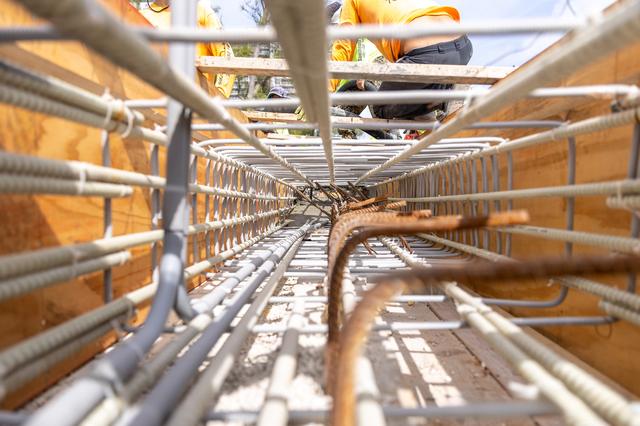- January 8, 2025
- Posted by: wellcoindustries
- Category: Rebar
Introduction
As construction technology advances, more industry professionals are turning to Fiber-Reinforced Polymer (FRP) rebar as a durable alternative to traditional steel reinforcement. FRP’s superior resistance to corrosion, high tensile strength, and lightweight nature make it an ideal choice for projects that demand longevity and resilience—particularly in corrosive or marine environments. However, to fully realize these benefits, it’s crucial to comply with recognized FRP rebar standards and codes, ensuring both safety and performance.

Understanding FRP Rebar
Defining FRP Rebar
FRP rebar is composed of high-strength fibers—like glass, carbon, or basalt—embedded in a polymeric resin matrix. Unlike steel, which is prone to rust and corrosion in certain conditions, FRP rebar remains stable even in chemically aggressive or high-humidity environments. By combining fibers and resin, FRP bars deliver a robust, non-corrosive reinforcement option that can outperform steel in specific applications.
Advantages of FRP Over Steel Rebar
- Corrosion Resistance: FRP rebar does not rust, making it ideal for marine structures or chlorinated environments.
- Lightweight Nature: Weighing significantly less than steel, FRP reduces transportation and installation costs.
- High Tensile Strength: FRP can have tensile strength comparable to or greater than steel, aiding in load-bearing capacity.
- Long-Term Durability: Projects that integrate FRP rebar often require less maintenance over their lifespan.
Key FRP Rebar Standards and Regulatory Bodies
ACI (American Concrete Institute) Standards
The American Concrete Institute has played a pivotal role in establishing guidelines for the use of FRP in concrete structures. ACI 440.1R provides recommendations for designing concrete reinforced with FRP, while ACI 440.6 sets quality-control and testing methods for FRP bars. These documents help engineers design, specify, and install FRP rebar confidently.
CSA (Canadian Standards Association) Guidelines
In Canada, CSA S806 outlines the design and construction requirements for buildings using FRP. Given the country’s diverse climate—from coastal to frigid prairie conditions—these standards ensure that FRP rebar is effectively implemented without compromising structural integrity.
Other Notable Organizations and Guidelines
- ASTM (American Society for Testing and Materials): Develops standard test methods (e.g., ASTM D7205) that assess tensile properties of FRP bars.
- ISO (International Organization for Standardization): Although more general, ISO can provide guidance on FRP materials’ quality assurance.
- fib (International Federation for Structural Concrete): Offers technical bulletins and design guidelines for advanced composite materials.
Best Practices for Ensuring Code Compliance
Material Testing and Quality Control
Before FRP bars enter the construction site, they typically undergo standardized tests. ASTM D7205 covers the test method for tensile properties of FRP bars, helping verify they meet project specifications. Continuous quality checks ensure each batch meets strength and durability requirements.
Proper Design and Installation
Designing FRP-reinforced elements often involves referencing ACI 440.1R, which provides insights on the allowable stress and strain limits. During installation, handling the bars with care is critical—excessive bending or surface damage can compromise structural performance. Using recommended anchor systems and connectors further ensures a reliable installation.
Documentation and Record-Keeping
Maintaining thorough documentation is key for code compliance. This includes test reports, batch certifications, and installation records. Regular inspections by certified professionals provide additional assurance that the FRP rebar meets industry standards.
Practical Applications of FRP Rebar
Marine and Coastal Structures
Saltwater environments and salt-based de-icing methods can severely corrode steel, but FRP’s resistance to rust makes it particularly advantageous for piers, wharfs, and waterfront infrastructures. While initial costs may be higher than steel, the reduced maintenance over time often results in overall savings.
Bridges and Highway Infrastructure
Bridges that experience heavy traffic loads and harsh weather benefit from FRP’s high tensile strength and corrosion resistance. As these structures demand long service lives, FRP rebar helps minimize repair and replacement costs.
Architectural and Commercial Buildings
Where aesthetics and functionality intersect, FRP rebar can be utilized without the risk of rust stains or spalling concrete. Non-magnetic properties also make it desirable for buildings requiring specialized equipment free from magnetic interference, such as MRI facilities or power plants.
Common Challenges and How to Overcome Them
Higher Initial Cost
While FRP typically carries a higher upfront cost, ongoing advancements in manufacturing processes are driving prices down. Additionally, the significantly lower maintenance requirements and extended service life can yield substantial long-term savings.
Lack of Universal Acceptance
Because codes vary by region, some building authorities may be slow to adopt new guidelines. Staying informed on the latest standards—like those from the ACI, CSA, or ASTM—and sharing successful case studies can help encourage wider acceptance.
Skilled Labor and Training
Proper installation calls for specific techniques and knowledge. Many FRP manufacturers offer training modules or certification programs to equip contractors and engineers with the expertise needed to handle, cut, and place FRP rebar safely.
Conclusion
FRP rebar offers a compelling alternative to steel in many construction projects, particularly those exposed to corrosive environments or requiring a long service life. By adhering to recognized standards and design guidelines, such as ACI 440.1R, CSA S806, and relevant ASTM testing methods, you ensure that FRP-reinforced structures meet rigorous safety and performance demands.
CTA: Ready to explore how FRP rebar can enhance your project’s durability and longevity? Consult the latest guidelines from ACI, CSA, and ASTM, and consider partnering with experienced suppliers or engineering firms to ensure a successful, code-compliant installation. By embracing FRP technology and the standards that govern it, you’ll be paving the way for safer, stronger, and more sustainable construction.
